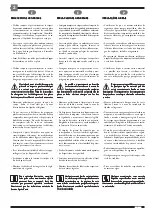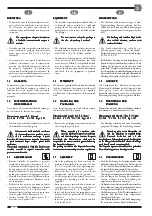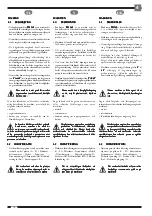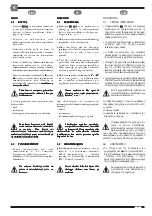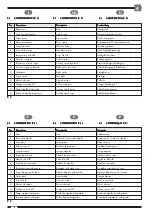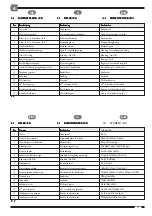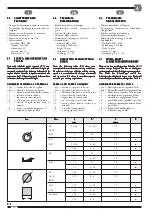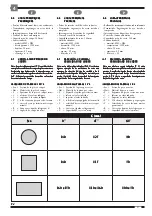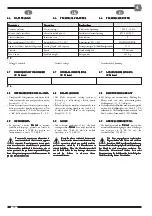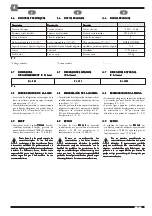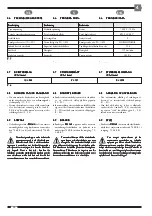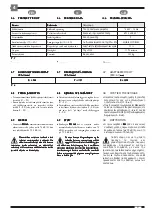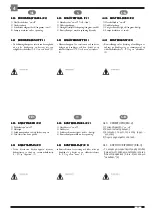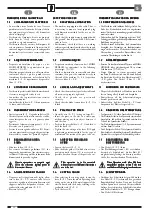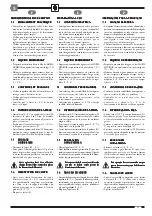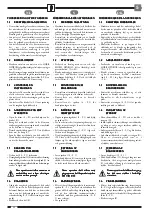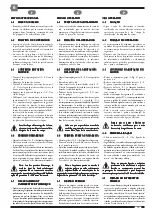
20
4
4.4
4.4
4.4
4.4
4.4
CARATTERISTICHE
CARATTERISTICHE
CARATTERISTICHE
CARATTERISTICHE
CARATTERISTICHE
TECNICHE
TECNICHE
TECNICHE
TECNICHE
TECNICHE
• Pulegge di trascinamento lama: su cuscinetti
• Trasmissione: ingranaggi in acciaio trattato e
temprato
• Interruttore con dispositivo di sicurezza
• Tendilama automatico
• Capacità max. di taglio: mm 160
• Lama standard:
- materiale: M42 - HSS
- sviluppo: mm 1900
- altezza: mm 20
- spessore: mm 0,9
- dentatura n.: 6 - 20
4.5
4.5
4.5
4.5
4.5
SCELTA: LAMA/VELOCITÀ DI
SCELTA: LAMA/VELOCITÀ DI
SCELTA: LAMA/VELOCITÀ DI
SCELTA: LAMA/VELOCITÀ DI
SCELTA: LAMA/VELOCITÀ DI
TAGLIO
TAGLIO
TAGLIO
TAGLIO
TAGLIO
Nota: nelle tabelle di seguito riportate (T. 3) sono
Nota: nelle tabelle di seguito riportate (T. 3) sono
Nota: nelle tabelle di seguito riportate (T. 3) sono
Nota: nelle tabelle di seguito riportate (T. 3) sono
Nota: nelle tabelle di seguito riportate (T. 3) sono
illustrati alcuni esempi delle condizioni di taglio più
illustrati alcuni esempi delle condizioni di taglio più
illustrati alcuni esempi delle condizioni di taglio più
illustrati alcuni esempi delle condizioni di taglio più
illustrati alcuni esempi delle condizioni di taglio più
comuni. La scelta del tipo di lama e della velocità di
comuni. La scelta del tipo di lama e della velocità di
comuni. La scelta del tipo di lama e della velocità di
comuni. La scelta del tipo di lama e della velocità di
comuni. La scelta del tipo di lama e della velocità di
taglio è infatti in funzione al tipo di materiale ed alla
taglio è infatti in funzione al tipo di materiale ed alla
taglio è infatti in funzione al tipo di materiale ed alla
taglio è infatti in funzione al tipo di materiale ed alla
taglio è infatti in funzione al tipo di materiale ed alla
sua sezione. La T. 4 illustra la capacità della macchina
sua sezione. La T. 4 illustra la capacità della macchina
sua sezione. La T. 4 illustra la capacità della macchina
sua sezione. La T. 4 illustra la capacità della macchina
sua sezione. La T. 4 illustra la capacità della macchina
in funzione delle angolazioni di taglio.
in funzione delle angolazioni di taglio.
in funzione delle angolazioni di taglio.
in funzione delle angolazioni di taglio.
in funzione delle angolazioni di taglio.
GLOSSARIO DI TABELLA 3 E TABELLA 4
GLOSSARIO DI TABELLA 3 E TABELLA 4
GLOSSARIO DI TABELLA 3 E TABELLA 4
GLOSSARIO DI TABELLA 3 E TABELLA 4
GLOSSARIO DI TABELLA 3 E TABELLA 4
• Sez. = Sezione del pezzo da tagliare
• Mat. = Materiale del pezzo da tagliare
• S
= Spessore del pezzo da tagliare (in mm)
• <
= inferiore al valore indicato
• >
= superiore al valore indicato
• Z”
= n
°
di denti per pollice, della lama
• V
= velocità di taglio (m/min: metri al
minuto)
• R
= Taglio con liquido refrigerante (•)
• C
= Capacità di taglio (in mm)
4.4
4.4
4.4
4.4
4.4
TECHNICAL
TECHNICAL
TECHNICAL
TECHNICAL
TECHNICAL
SPECIFICATIONS
SPECIFICATIONS
SPECIFICATIONS
SPECIFICATIONS
SPECIFICATIONS
• Blade drive pulleys: on bearings
• Transmission: treated, tempered steel
gears
• Switch with safety device
• Automatic blade stretcher
• Maximum cutting capacity: 160 mm.
• Standard blade:
- material: M42 – HSS
- developing: 1900 mm.
- height: 20 mm.
- thickness: 0,9 mm.
- toothing n.: 6 - 20
4.4
4.4
4.4
4.4
4.4
TECHNISCHE
TECHNISCHE
TECHNISCHE
TECHNISCHE
TECHNISCHE
EIGENSCHAFTEN
EIGENSCHAFTEN
EIGENSCHAFTEN
EIGENSCHAFTEN
EIGENSCHAFTEN
• Blattantriebsscheibe: auf Lagern
• Übertragung: temperiertes, behandeltes
Stahlgetriebe
• Schalter mit Schutzvorrichtung
• Automatischer Blattspanner
• Maximale Schnittleistung: 160 mm
• Standardblatt:
- Werkstoff: M42 - HSS
- Ausdehnung: 1900 mm
- Höhe: 20 mm
- Stärke: 0,9 mm
- Verzahnung: Nr.: 6 - 20
4.5
4.5
4.5
4.5
4.5
SELECTION: BLADE/CUTTING
SELECTION: BLADE/CUTTING
SELECTION: BLADE/CUTTING
SELECTION: BLADE/CUTTING
SELECTION: BLADE/CUTTING
SPEED
SPEED
SPEED
SPEED
SPEED
Note: the following tables (T.3) show some
Note: the following tables (T.3) show some
Note: the following tables (T.3) show some
Note: the following tables (T.3) show some
Note: the following tables (T.3) show some
examples of the most common cutting conditions.
examples of the most common cutting conditions.
examples of the most common cutting conditions.
examples of the most common cutting conditions.
examples of the most common cutting conditions.
The choice of the type of blade and the cutting
The choice of the type of blade and the cutting
The choice of the type of blade and the cutting
The choice of the type of blade and the cutting
The choice of the type of blade and the cutting
speed is in accordance with the type of material
speed is in accordance with the type of material
speed is in accordance with the type of material
speed is in accordance with the type of material
speed is in accordance with the type of material
and its section. T.4 shows the machine capacity
and its section. T.4 shows the machine capacity
and its section. T.4 shows the machine capacity
and its section. T.4 shows the machine capacity
and its section. T.4 shows the machine capacity
according to cutting angulations.
according to cutting angulations.
according to cutting angulations.
according to cutting angulations.
according to cutting angulations.
TABLE 3 AND TABLE 4 GLOSSARY
TABLE 3 AND TABLE 4 GLOSSARY
TABLE 3 AND TABLE 4 GLOSSARY
TABLE 3 AND TABLE 4 GLOSSARY
TABLE 3 AND TABLE 4 GLOSSARY
• Sez. = Section of the piece to be cut
• Mat. = Material of the piece to be cut
• S
= Thickness of the piece to be cut (in mm.)
• <
= lower than the stated value
• >
= higher than the stated value
• Z’’
= no. of teeth per inch of the blade
• V
= cutting speed (m/min: metres per
minute)
• R
= Cut with cooling liquid (•)
• C
= Cutting capacity (in mm.)
4.5
4.5
4.5
4.5
4.5
WAHL: BLATT/
WAHL: BLATT/
WAHL: BLATT/
WAHL: BLATT/
WAHL: BLATT/
SCHNITTGESCHWINDIGKEIT
SCHNITTGESCHWINDIGKEIT
SCHNITTGESCHWINDIGKEIT
SCHNITTGESCHWINDIGKEIT
SCHNITTGESCHWINDIGKEIT
Hinweis: in den nachfolgenden Tabellen (T. 3)
Hinweis: in den nachfolgenden Tabellen (T. 3)
Hinweis: in den nachfolgenden Tabellen (T. 3)
Hinweis: in den nachfolgenden Tabellen (T. 3)
Hinweis: in den nachfolgenden Tabellen (T. 3)
werden einige Beispiele für die am häufigsten
werden einige Beispiele für die am häufigsten
werden einige Beispiele für die am häufigsten
werden einige Beispiele für die am häufigsten
werden einige Beispiele für die am häufigsten
vorkommenden Schnittbedingungen angegeben.
vorkommenden Schnittbedingungen angegeben.
vorkommenden Schnittbedingungen angegeben.
vorkommenden Schnittbedingungen angegeben.
vorkommenden Schnittbedingungen angegeben.
Die Wahl des Blatt-Typs sowie der
Die Wahl des Blatt-Typs sowie der
Die Wahl des Blatt-Typs sowie der
Die Wahl des Blatt-Typs sowie der
Die Wahl des Blatt-Typs sowie der
Schnittgeschwindigkeit hängen vom Werkstoff
Schnittgeschwindigkeit hängen vom Werkstoff
Schnittgeschwindigkeit hängen vom Werkstoff
Schnittgeschwindigkeit hängen vom Werkstoff
Schnittgeschwindigkeit hängen vom Werkstoff
sowie vom Querschnitt des zu sägenden Teils ab.
sowie vom Querschnitt des zu sägenden Teils ab.
sowie vom Querschnitt des zu sägenden Teils ab.
sowie vom Querschnitt des zu sägenden Teils ab.
sowie vom Querschnitt des zu sägenden Teils ab.
GLOSSAR ZUR TABELLE 3 UND 4
GLOSSAR ZUR TABELLE 3 UND 4
GLOSSAR ZUR TABELLE 3 UND 4
GLOSSAR ZUR TABELLE 3 UND 4
GLOSSAR ZUR TABELLE 3 UND 4
• Sez. = Querschnitt des zu sägenden Teils
• Mat. = Material (Werkstoff) des zu sägenden Teils
• S
= Stärke des zu sägenden Teils (in mm)
• <
= unterhalb des angegebenen Wertes
• >
= oberhalb des angegebenen Wertes
• Z”
= Anzahl Zähne des Sägeblattes pro Zoll
• V
= Schnittgeschwindigkeit (m/min: Meter
pro Minute)
• R
= Schnitt mit Kühlflüssigkeit (•)
• C
= Schnittleistung (in mm)
Sez.
Sez.
Sez.
Sez.
Sez.
Mat.
Mat.
Mat.
Mat.
Mat.
SSSSS
Z”
Z”
Z”
Z”
Z”
V
V
V
V
V
R
RR
R
R
mm
mm
mm
mm
mm
m/min
m/min
m/min
m/min
m/min
All
5
÷
20
6
÷
10
70
Ot 58
Br 14
< 5
14
70
Fe 35
< 5
14
70
•
Fe 52
5
÷
20
6 - 10
70
•
> 20
4 - 6
70
•
All
< 5
14
70
> 5
6 - 10
70
Fe 37
< 5
14
70
•
> 5
6 - 10
35
•
All
< 50
6 - 10
70
Ot 58
> 50
4 - 6
70
Br 14
Fe 37
< 50
6 - 10
35
•
C 40
> 50
4 - 6
35
•
Acc. Inox
< 50
6 - 10
35
•
> 50
4 - 6
35
•
T. 3
T. 3
T. 3
T. 3
T. 3
S
S
S
S
I
UK
D
Summary of Contents for PH160
Page 51: ......


